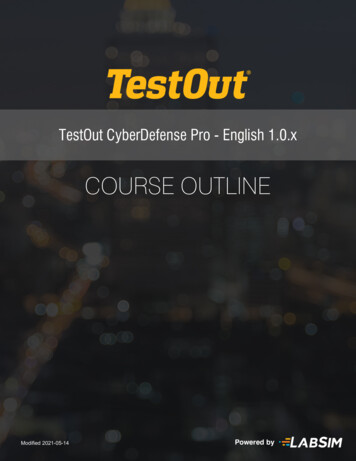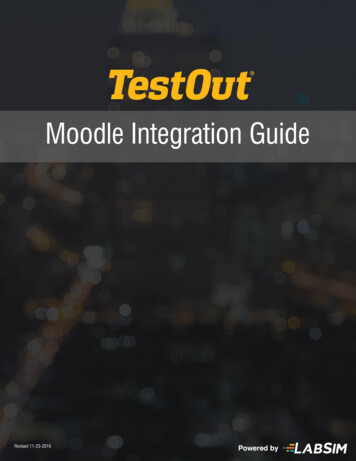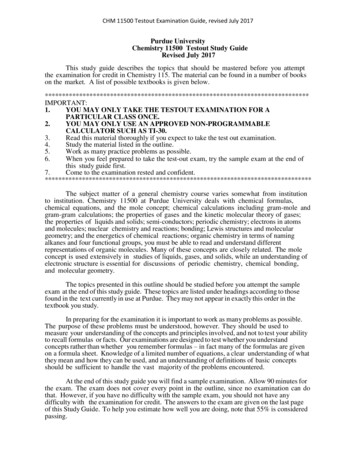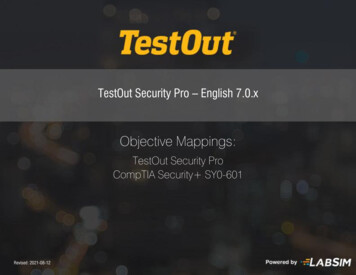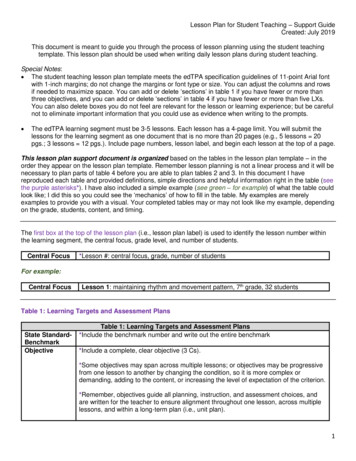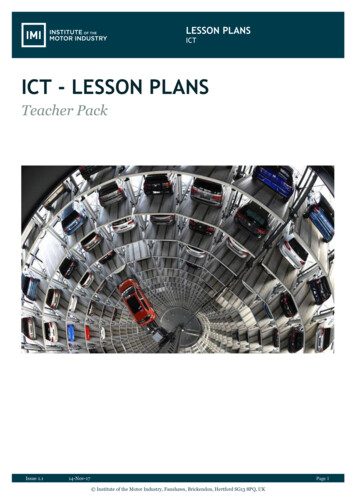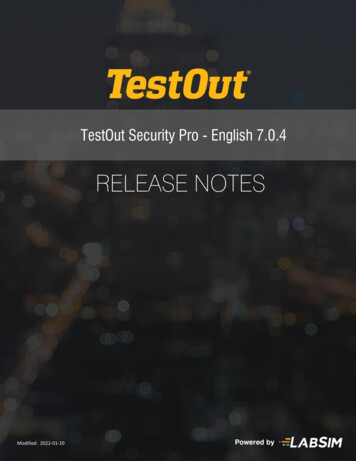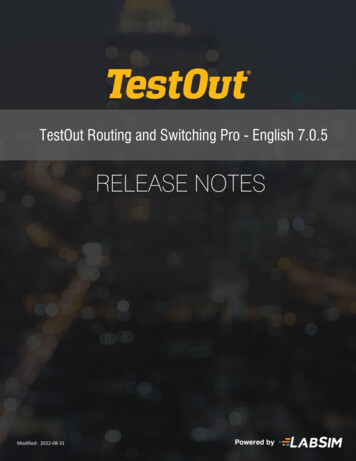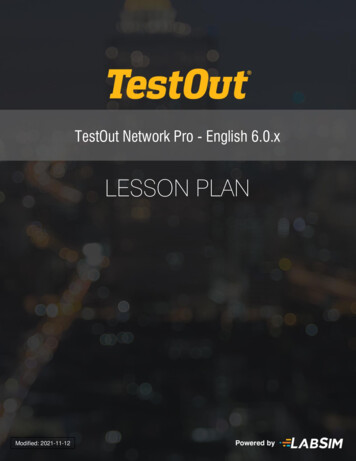
Transcription
TestOut Network Pro - English 6.0.xLESSON PLANModified: 2021-11-12
2Table of ContentsTable of Contents . 2Introduction . 41.1: Network Pro Introduction . 41.2: Use the Simulator . 5Networking Basics . 62.1: Networking Overview . 62.2: OSI Model and Data Encapsulation . 92.3: Data Encapsulation. 112.4: Network Protocols. 13Network Cabling and Hardware Devices . 153.1: Copper Cables and Connectors . 153.2: Fiber Optic Cables and Connectors . 173.3: Wiring Implementation . 193.4: Troubleshoot Network Media . 213.5: Network Adapters . 243.6: Networking Devices . 27Network Addressing and Services . 304.1: IP Addressing . 304.2: APIPA and Alternate Addressing. 334.3: DHCP . 354.4: DHCP Relay . 374.5: DNS . 394.6: NTP . 424.7: IP Version 6 . 444.8: Multicast . 464.9: Troubleshoot IP Configuration Issues . 484.10: Troubleshoot IP Communications . 504.11: Troubleshoot DNS . 52Ethernet . 545.1: Ethernet . 545.2: Connect Network Devices . 565.3: Troubleshoot Physical Connectivity. 58Firewalls and Intrusion Detection . 606.1: Firewalls . 606.2: Firewall Design and Implementation . 626.3: Screened Subnets (DMZ) . 646.4: Intrusion Detection and Prevention . 66Switching and Routing . 687.1: Switching . 687.2: Basic Switch Configuration . 707.3: Switch Ports . 727.4: Switch Security . 757.5: Routing . 787.6: Network Address Translation . 807.7: Switching and Routing Troubleshooting . 82Specialized Networks . 848.1: Corporate and Datacenter Networks . 848.2: Voice over IP (VoIP) . 868.3: Virtualization . 888.4: Virtual Networking. 908.5: Cloud Concepts and Connectivity . 92Copyright 2021 CompTIA, A , Network , Security , Linux , IT Fundamentals, Cybersecurity Analyst (CySA ), and relatedtrademarks are the trademarks of CompTIA. Microsoft, MCITP, MSCA, MCTS, Office, and Windows are the trademarks ofMicrosoft. Cisco and CCNA are the trademarks of Cisco. Certified Ethical Hacker and CEH are the trademarks of the EC-Council.TestOut has no affiliation with these companies and the products and services advertised herein are not endorsed by any of them.
38.6: Internet of Things (IoT) . 95Wireless Networking . 979.1: Wireless Concepts and Standards . 979.2: Wireless Configuration. 1009.3: Wireless Network Design . 1029.4: Wireless Network Implementation . 1049.5: Wireless Security . 1069.6: Wireless Troubleshooting . 109Wide Area Networks (WANs) . 11210.1: WAN Concepts . 11210.2: Internet Connectivity . 11510.3: Remote Access. 11710.4: Virtual Private Networks . 119Network Operations and Management . 12111.1: Performance Metrics . 12111.2: Network Management with SNMP. 12311.3: Log File Management . 12511.4: Monitoring . 12711.5: Organization Policies . 12911.6: Redundancy and High Availability . 13111.7: Data Backup and Storage . 13411.8: Remote Management . 136Network Security . 13812.1: Security Concepts. 13812.2: Risk Management . 14112.3: Physical Security . 14312.4: Social Engineering . 14512.5: Network Threats and Attacks . 14712.6: Spoofing Attacks . 151Hardening and Update Management . 15413.1: Network Hardening . 15413.2: Authentication . 15713.3: Hardening Authentication . 15913.4: Update Management . 161Network Optimization and Troubleshooting . 16314.1: Optimization . 16314.2: General Network Issues . 16614.3: Troubleshooting Utilities . 169Practice Exams . 172Appendix A: Approximate Time for the Course . 173Copyright 2021 CompTIA, A , Network , Security , Linux , IT Fundamentals, Cybersecurity Analyst (CySA ), and relatedtrademarks are the trademarks of CompTIA. Microsoft, MCITP, MSCA, MCTS, Office, and Windows are the trademarks ofMicrosoft. Cisco and CCNA are the trademarks of Cisco. Certified Ethical Hacker and CEH are the trademarks of the EC-Council.TestOut has no affiliation with these companies and the products and services advertised herein are not endorsed by any of them.
4Introduction1.1: Network Pro IntroductionLecture Focus Questions: What are the course prerequisites?Which major topics are covered in the course?Which certification does this course prepare you for?Video/Demo1.1.1 Network Pro IntroductionTotal Video TimeTime4:154:15Total TimeAbout 5 minutesCopyright 2021 CompTIA, A , Network , Security , Linux , IT Fundamentals, Cybersecurity Analyst (CySA ), and relatedtrademarks are the trademarks of CompTIA. Microsoft, MCITP, MSCA, MCTS, Office, and Windows are the trademarks ofMicrosoft. Cisco and CCNA are the trademarks of Cisco. Certified Ethical Hacker and CEH are the trademarks of the EC-Council.TestOut has no affiliation with these companies and the products and services advertised herein are not endorsed by any of them.
51.2: Use the SimulatorSummaryIn this section, you will learn to: Read simulated component documentation and view components to makeappropriate choices and meet the scenario's requirements.Add and remove simulated computer components.Change views and navigate between floors and buildings to view and addsimulated components.Use the zoom feature to view additional image details.Use the simulation interface to identify where simulated cables connect to thecomputer.Attach simulated cables.Configure services on Hyper-V guest servers.Video/DemoTime1.2.1 Use the SimulatorTotal Video Time14:5614:56Lab/Activity1.2.2 Explore a Single Location in a Lab1.2.3 Explore Multiple Locations in a LabFact Sheets1.2.4 Networking Rack FactsTotal TimeAbout 39 minutesCopyright 2021 CompTIA, A , Network , Security , Linux , IT Fundamentals, Cybersecurity Analyst (CySA ), and relatedtrademarks are the trademarks of CompTIA. Microsoft, MCITP, MSCA, MCTS, Office, and Windows are the trademarks ofMicrosoft. Cisco and CCNA are the trademarks of Cisco. Certified Ethical Hacker and CEH are the trademarks of the EC-Council.TestOut has no affiliation with these companies and the products and services advertised herein are not endorsed by any of them.
6Networking Basics2.1: Networking OverviewLecture Focus Questions: Why are protocols important for networking?What are the advantages of a client-server network as compared to a peer-topeer network?What is defined by the logical topology?How does the logical topology differ from the physical topology?Why can a single physical topology support multiple logical topologies?Why is a physical mesh topology normally an impractical solution?Key terms for this section include the following:TermDefinitionInternet ProtocolAn address that identifies the network and host addressaddressassigned to a device.(IP address)The portion of the IP address that identifies the network theSubnet addressdevice is assigned to.A group of computers and associated devices that share aLocal area networkcommon communications line or wireless link, typically to a(LAN)server.Metropolitan areaComputer users and resources within a geographic area thenetworksize of a metropolitan area that are connected.(MAN)A network that connects several LANs. WANs are often limitedWide area networkto a corporation or an organization but are sometimes(WAN)accessible to the public.Software-definedwide area network A WAN that uses software to control connectivity.(SDWAN)Multipoint GenericRoutingA tunnel interface.Encapsulation(mGRE)A collection of many networks owned by many entities thatInternetshare information and communicate together.A local or restricted communications network, especially aIntranetprivate network created using World Wide Web software.Copyright 2021 CompTIA, A , Network , Security , Linux , IT Fundamentals, Cybersecurity Analyst (CySA ), and relatedtrademarks are the trademarks of CompTIA. Microsoft, MCITP, MSCA, MCTS, Office, and Windows are the trademarks ofMicrosoft. Cisco and CCNA are the trademarks of Cisco. Certified Ethical Hacker and CEH are the trademarks of the EC-Council.TestOut has no affiliation with these companies and the products and services advertised herein are not endorsed by any of them.
7An intranet that can be partially accessed by authorized outsideusers, enabling businesses to exchange information over theinternet securely.The term used to describe how devices are connected and howmessages flow from device to device. The physical topologyTopologydescribes the way the network is wired. The logical topologydescribes the way messages are sent.A device that is connected to absorb signals and prevent themTerminatorfrom reflecting repeatedly back and forth on the cable.Terminators are used with bus topology.This section helps you prepare for the following certification exam objectives:ExamObjective1.2 Explain the characteristics of network topologies andnetwork types.Extranet CompTIA Network N10-0081.2.1 Mesh1.2.2 Star/hub-and-spoke1.2.3 Bus1.2.4 Ring1.2.5 Hybrid1.2.6 Network types and characteristicso Peer-to-peero Client-servero Local area network (LAN)o Metropolitan area network (MAN)o Wide area network (WAN)o Wireless local area network (WLAN)o Personal area network (PAN)o Campus area network (CAN)o Storage area network (SAN)o Software-defined wide area network (SDWAN)o Multipoint generic routing encapsulation(mGRE)Video/DemoTime2.1.1 Introduction to Networking2.1.2 Network Types2.1.3 Networking Terms2.1.5 Network TopologiesTotal Video Time5:179:029:287:0930:56Fact Sheets2.1.4 Networking FactsCopyright 2021 CompTIA, A , Network , Security , Linux , IT Fundamentals, Cybersecurity Analyst (CySA ), and relatedtrademarks are the trademarks of CompTIA. Microsoft, MCITP, MSCA, MCTS, Office, and Windows are the trademarks ofMicrosoft. Cisco and CCNA are the trademarks of Cisco. Certified Ethical Hacker and CEH are the trademarks of the EC-Council.TestOut has no affiliation with these companies and the products and services advertised herein are not endorsed by any of them.
82.1.6 Network Topology FactsNumber of Exam Questions10 questionsTotal TimeAbout 51 minutesCopyright 2021 CompTIA, A , Network , Security , Linux , IT Fundamentals, Cybersecurity Analyst (CySA ), and relatedtrademarks are the trademarks of CompTIA. Microsoft, MCITP, MSCA, MCTS, Office, and Windows are the trademarks ofMicrosoft. Cisco and CCNA are the trademarks of Cisco. Certified Ethical Hacker and CEH are the trademarks of the EC-Council.TestOut has no affiliation with these companies and the products and services advertised herein are not endorsed by any of them.
92.2: OSI Model and Data EncapsulationLecture Focus Questions: What is the OSI model? Why is it important for understanding networking?What are the advantages of using a theoretical model to describe networking?What is the name of Layer 3 in the OSI model? Layer 5?Which OSI model layers typically correspond to the network architecture?How does the session ID differ from the port number?Which OSI model layer would you find a frame at?What is the difference between connectionless and connection-orientedservices?The key terms for this section include:TermDefinitionOpen SystemsA reference model for how applications communicate overInterconnection (OSI)a network without regard to its underlying internal structureModeland technology.This section helps you prepare for the following certification exam objectives:ExamObjective1.1 Compare and contrast the Open Systems Interconnection(OSI) model layers and encapsulation concepts. CompTIANetwork N100081.1.1 OSI modelo Layer 1 - Physicalo Layer 2 - Data linko Layer 3 - Networko Layer 4 - Transporto Layer 5 - Sessiono Layer 6 - Presentationo Layer 7 - ApplicationVideo/DemoTime2.2.1 The OSI Model2.2.3 OSI Model Layers2.2.4 OSI Model CommunicationsTotal Video Time3:037:583:1614:17Fact Sheets2.2.2 OSI Model Facts2.2.5 OSI Layers FactsNumber of Exam QuestionsCopyright 2021 CompTIA, A , Network , Security , Linux , IT Fundamentals, Cybersecurity Analyst (CySA ), and relatedtrademarks are the trademarks of CompTIA. Microsoft, MCITP, MSCA, MCTS, Office, and Windows are the trademarks ofMicrosoft. Cisco and CCNA are the trademarks of Cisco. Certified Ethical Hacker and CEH are the trademarks of the EC-Council.TestOut has no affiliation with these companies and the products and services advertised herein are not endorsed by any of them.
1010 questionsTotal TimeAbout 35 minutesCopyright 2021 CompTIA, A , Network , Security , Linux , IT Fundamentals, Cybersecurity Analyst (CySA ), and relatedtrademarks are the trademarks of CompTIA. Microsoft, MCITP, MSCA, MCTS, Office, and Windows are the trademarks ofMicrosoft. Cisco and CCNA are the trademarks of Cisco. Certified Ethical Hacker and CEH are the trademarks of the EC-Council.TestOut has no affiliation with these companies and the products and services advertised herein are not endorsed by any of them.
112.3: Data EncapsulationLecture Focus Questions: How does data encapsulation facilitate data transmission?What are the TCP/IP encapsulation process steps on a sending host?What are the TCP/IP de-encapsulation process steps?What are TCP flags?How do packets and frames work?Key terms for this section include the following:TermDefinitionTransmissionTCP is one of the main internet protocols. It allows computingControl Protocoldevices and application devices to exchange messages over a(TCP)network.Address ResolutionARP is used to determine the MAC address of the host usingProtocolthe destination IP address.(ARP)MaximumMTU is the largest size data unit that can be transmitted throughtransmission unitthe network.(MTU)This section helps you prepare for the following certification exam objectives:ExamObjective1.1 Compare and contrast the Open Systems Interconnection (OSI)model layers and encapsulation concepts. CompTIAN10-0081.1.2 Data encapsulation and decapsulation within the OSImodel contexto Ethernet headero Internet Protocol (IP) headero Transmission Control Protocol (TCP)/User DatagramProtocol (UDP) headerso TCP flagso Payloado Maximum transmission unit (MTU)2.3 Given a scenario, configure and deploy common Ethernetswitching features. 2.3.8 Address Resolution Protocol (ARP)Video/Demo2.3.1 Data EncapsulationTime5:21Copyright 2021 CompTIA, A , Network , Security , Linux , IT Fundamentals, Cybersecurity Analyst (CySA ), and relatedtrademarks are the trademarks of CompTIA. Microsoft, MCITP, MSCA, MCTS, Office, and Windows are the trademarks ofMicrosoft. Cisco and CCNA are the trademarks of Cisco. Certified Ethical Hacker and CEH are the trademarks of the EC-Council.TestOut has no affiliation with these companies and the products and services advertised herein are not endorsed by any of them.
122.3.3 Address Resolution Protocol (ARP)2.3.4 Packets and Frames2.3.6 Three-Way Handshake and TCP FlagsTotal Video Time4:265:583:2819:13Fact Sheets2.3.2 Data Encapsulation Facts2.3.5 Network Communication Process Facts2.3.7 Three-Way Handshake and TCP Flags FactsNumber of Exam Questions10 questionsTotal TimeAbout 45 minutesCopyright 2021 CompTIA, A , Network , Security , Linux , IT Fundamentals, Cybersecurity Analyst (CySA ), and relatedtrademarks are the trademarks of CompTIA. Microsoft, MCITP, MSCA, MCTS, Office, and Windows are the trademarks ofMicrosoft. Cisco and CCNA are the trademarks of Cisco. Certified Ethical Hacker and CEH are the trademarks of the EC-Council.TestOut has no affiliation with these companies and the products and services advertised herein are not endorsed by any of them.
132.4: Network ProtocolsLecture Focus Questions: How does a protocol suite differ from a protocol?How does TCP differ from UDP?What are the differences between the three email protocols (IMAP4, POP3, andSMTP)?How does SSH differ from Telnet? How does HTTPS differ from HTTP?In this section, you will learn to: Explore network servicesThe key terms for this section include:TermDefinitionA protocol is a set of standards for communication between networkProtocolhosts.The Internet Protocol suite (frequently referred to as TCP/IP) is aInternetconceptual model and set of communications protocols used on theProtocolinternet and similar computer networks. The foundational protocols in thissuitesuite are Transmission Control Protocol (TCP) and Internet Protocol.This section helps you prepare for the following certification exam objectives:ExamObjective1.5 Explain common ports and protocols, their application, andencrypted alternatives.CompTIA Network N10-008 1.5.1 File Transfer Protocol (FTP) 20/211.5.2 Secure Shell (SSH) 221.5.3 Secure File Transfer Protocol (SFTP) 221.5.4 Telnet 231.5.5 Simple Mail Transfer Protocol (SMTP) 251.5.6 Domain Name System (DNS) 531.5.7 Dynamic Host Configuration Protocol (DHCP)67/681.5.8 Trivial File Transfer Protocol (TFTP) 691.5.9 Hypertext Transfer Protocol (HTTP) 801.5.10 Post Office Protocol v3 (POP3) 1101.5.11 Network Time Protocol (NTP) 1231.5.12 Internet Message Access Protocol (IMAP) 1431.5.13 Simple Network Management Protocol (SNMP)161/1621.5.14 Lightweight Directory Access Protocol (LDAP)389Copyright 2021 CompTIA, A , Network , Security , Linux , IT Fundamentals, Cybersecurity Analyst (CySA ), and relatedtrademarks are the trademarks of CompTIA. Microsoft, MCITP, MSCA, MCTS, Office, and Windows are the trademarks ofMicrosoft. Cisco and CCNA are the trademarks of Cisco. Certified Ethical Hacker and CEH are the trademarks of the EC-Council.TestOut has no affiliation with these companies and the products and services advertised herein are not endorsed by any of them.
14 1.5.15 Hypertext Transfer Protocol Secure (HTTPS)[Secure Sockets Layer (SSL)] 4431.5.16 HTTPS [Transport Layer Security (TLS)] 4431.5.17 Server Message Block (SMB) 4451.5.18 Syslog 5141.5.19 SMTP TLS 5871.5.20 Lightweight Directory Access Protocol (over SSL)(LDAPS) 6361.5.21 IMAP over SSL 9931.5.22 POP3 over SSL 9951.5.23 Structured Query Language (SQL) Server 14331.5.24 SQLnet 15211.5.25 MySQL 33061.5.26 Remote Desktop Protocol (RDP) 33891.5.27 Session Initiation Protocol (SIP) 5060/5061Video/DemoTime2.4.1 TCP/IP Protocols2.4.2 Common Network Services2.4.3 Explore Network ServicesTotal Video Time7:585:598:4322:40Fact Sheets2.4.4 Network Port and Protocol Facts2.4.5 Common PortsNumber of Exam Questions10 questionsTotal TimeAbout 43 minutesCopyright 2021 CompTIA, A , Network , Security , Linux , IT Fundamentals, Cybersecurity Analyst (CySA ), and relatedtrademarks are the trademarks of CompTIA. Microsoft, MCITP, MSCA, MCTS, Office, and Windows are the trademarks ofMicrosoft. Cisco and CCNA are the trademarks of Cisco. Certified Ethical Hacker and CEH are the trademarks of the EC-Council.TestOut has no affiliation with these companies and the products and services advertised herein are not endorsed by any of them.
15Network Cabling and HardwareDevices3.1: Copper Cables and ConnectorsLecture Focus Questions: Why are wires twisted together in twisted pair cables?What is the difference between STP cabling and UTP cabling?What is the difference between Cat 3, Cat 5e, and Cat 6a cables?How can you tell the difference between RJ11 and RJ45 connectors?You have an installation that requires Cat 5 cabling. Which cable ratings couldyou use for the installation?In this section, you will learn to: Connect to an Ethernet network.Connect a cable modem.The key terms for this section include:TermDefinitionCrosstalkAn unwanted transfer of signals between communication channels.Two twisted wires that carry the data signals (one conductor carries aUnshieldedpositive signal; one carries a negative signal). Twisting the cablestwisted pairreduces the effects of electromagnetic interference (EMI) and(UTP)crosstalk.ShieldedShielded twisted pair (STP) has a grounded outer copper shieldtwisted pair around the bundle of twisted pairs or around each pair. This provides(STP)added protection against EMI.A ple
LESSON PLAN - TestOut . Pro

